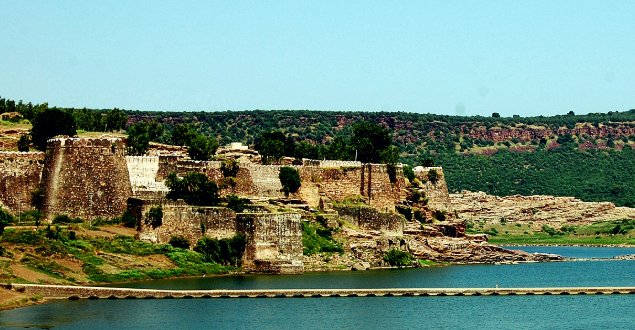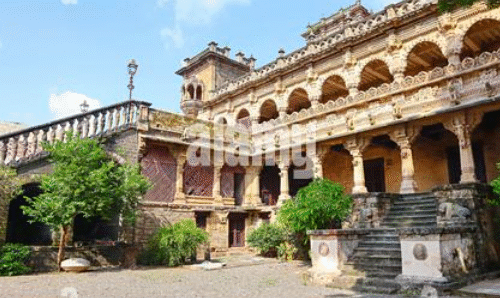Gagron Fort is a remarkable fusion of nature, architecture, and history. Its strategic location, unique construction, and cultural significance make it a standout example of India’s rich heritage. Visiting Gagron Fort offers a glimpse into the past, showcasing the ingenuity and resilience of its creators. Whether you’re a history buff, architecture enthusiast, or someone seeking to explore Rajasthan’s cultural treasures, Gagron Fort is a destination worth experiencing.
Introduction to Gagron Fort
Gagron Fort is a remarkable example of a ‘Jal Durg’ or water fort, located in Jhalawar district, Rajasthan. This fort stands as a testament to the architectural brilliance and strategic ingenuity of its creators. Surrounded by the confluence of the Ahu and Kali Sindh rivers on three sides, it offers a breathtaking view of the surrounding landscape.
Read About:- Ranthambore Fort – A Timeless Symbol of Rajput Strength and History
Historical Significance of Gagron Fort
The history of Gagron Fort dates back to the 12th century. It was initially constructed by Raja Bijaldev Singh Dod, a Parmar Rajput king. Over the centuries, the fort witnessed numerous battles and changes in rulership. Notably, in 1423, Sultan Hoshang Shah of Malwa laid siege to the fort with a massive army.

The fort’s defenders, led by Raja Achaldas Khinchi, chose to fight valiantly rather than surrender. This led to the tragic incident of ‘Jauhar,’ where many women committed self-immolation to protect their honor.
In the 16th century, the fort came under the control of Mughal emperors, including Sher Shah Suri and Akbar. Akbar even made it a headquarters before gifting it to Prathviraj of Bikaner as part of his estate.
Strategic Location
Gagron Fort is strategically situated at the confluence of the Ahu and Kali Sindh rivers. Its location on a hilltop provided a natural defense, making it nearly impregnable. The fort’s design takes advantage of its surroundings, with the rivers acting as moats and the hills offering elevated vantage points.
Architectural Marvel
The architecture of Gagron Fort is a blend of Rajput and Islamic styles. One of its most unique features is that it was built without a traditional foundation. Instead, the fort’s walls and towers are integrated into the Mukundara Hills of the Vindhya Range. This innovative construction method has contributed to its resilience over the centuries.
The fort boasts three ramparts, a feature uncommon in traditional forts, which typically have two. It also has two main entrances: one leading towards the river and the other towards the hilly road. Inside, visitors can explore various structures, including:
- Ganesh Pol: A grand entrance adorned with intricate carvings.
- Nakkarkhana: The place where musical instruments were played to announce royal events.
- Bhairavi Pol: Another significant gate within the fort complex.
- Kishan Pole: A gate leading to the inner sanctum of the fort.
- Selekhana: A narrow passageway used for defense purposes.
- Dewan-i-Aam: The hall for public audiences.
- Diwan-e-Khas: The hall for private meetings.
- Janaana Mahal: The women’s quarters.
- Madhusudan Mandir: A temple dedicated to Lord Krishna.
- Rang Mahal: The palace adorned with vibrant frescoes.

Cultural Heritage
Gagron Fort is not only a military stronghold but also a center of cultural significance. The fort houses several temples dedicated to Hindu deities, including Lord Shiva, Lord Ganesha, and Goddess Durga. These temples reflect the spiritual life that once thrived within the fort’s walls.
Just outside the fort lies the mausoleum of Sufi Saint Mitthe Shah. This site is of great religious importance, and an annual fair is held here during the Islamic month of Muharram, attracting devotees from various regions.
Modern-Day Relevance
Today, Gagron Fort stands as a UNESCO World Heritage Site, recognized for its unique blend of natural and architectural defenses. It attracts tourists and history enthusiasts who wish to delve into Rajasthan’s rich past. The fort’s well-preserved structures and scenic surroundings make it a popular destination for travelers seeking to experience the grandeur of India’s historical architecture.
Conclusion
Gagron Fort is a remarkable fusion of nature, architecture, and history. Its strategic location, unique construction, and cultural significance make it a standout example of India’s rich heritage. Visiting Gagron Fort offers a glimpse into the past, showcasing the ingenuity and resilience of its creators. Whether you’re a history buff, architecture enthusiast, or someone seeking to explore Rajasthan’s cultural treasures, Gagron Fort is a destination worth experiencing. Read More




